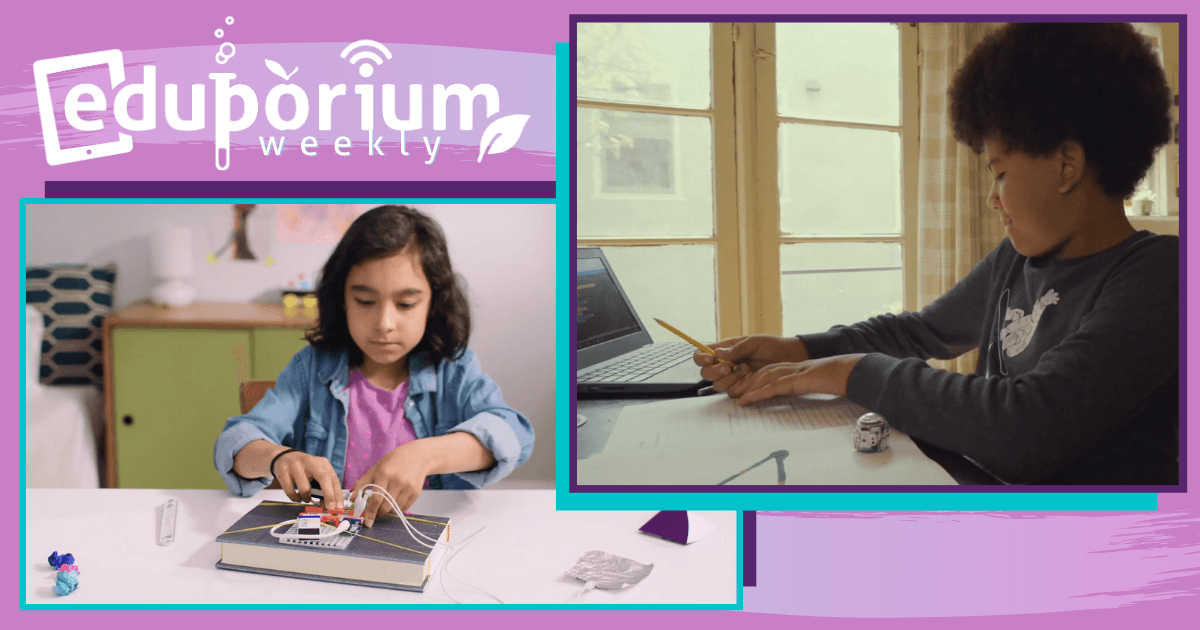When education went online, many students lost the hands-on opportunities they had in the classroom. Over time, however, educators have learned how to adapt key instructional approaches to remote environments. These include STEM experiences as well as project-based learning (or PBL). PBL involves students working as part of a group most of the time on a community-focused project designed to affect authentic change. You can see how this might be tough to do in a remote environment, but a lot of progress has been made. It takes true teamwork, but PBL IRL (in remote learning) is certainly a possibility.
Bringing PBL to Remote Learning
In remote learning, your natural view might be to put PBL on the back burner. In reality, however, it can still be a part of remote endeavors and allow students to have these valuable experiences. PBL is fantastic for student engagement, agency, and drawing real-world connections. It's all about transferring those purposefully designed experiences to the virtual classroom. Though tough, teachers are able to use some of the same strategies with alterations. The remote PBL experiences can often be just as powerful as those in the traditional classroom and help bridge some of the gaps created by remote learning. Having a plan in place, however, is an important first step.
Getting started with PBL.
To make remote PBL successful, there are a few tips educators can follow. The first of those is to lead students with purpose. Being caring and compassionate while introducing new projects can go a long way. This is how educators can help establish connections among students. Though that social connection is something most students have been craving for the better part of a year, it can still sometimes be tricky to facilitate. Setting up group projects, however, allows students to re-establish some of those connections with friends. In terms of equity, educators likely also need to consider the resources each student has. This may affect project choices or design, but it's an important factor for all these days.
Tips for remote PBL.
Since PBL is not a traditional remote learning strategy, educators also need to consider the home situations of their students. If projects require additional supplies or for students to go out in the community, this might present a problem. They may not have transportation or parents may be too anxious having them out and about while the pandemic continues on. Finally, as projects are being designed, try to create as many opportunities for student voice and choice as possible. This could allow them to choose a project they're really passionate about. Also, in presenting their findings, choice in the format can be important since students might have access to different technologies. Allowing for these options is important and can make PBL possible for today's students.
Making Remote PBL a Reality
Much of remote learning involves students and teachers covering the most basic and important concepts. The goal here? To ensure students get at least something out of their time away from the classroom. In order to truly challenge them and get them thinking like we know they can, PBL can help educators create some powerful learning experiences. Project-based learning often makes up some of the more effective learning experiences students have. Among other benefits, students can learn key research, collaboration, and revision skills. And, these skills often translate into lifelong use.
Providing options in remote learning.
PBL experiences, of course, typically take place in a classroom with groups of students. Small groups in the same location make it easier for educators to monitor progress and provide feedback. Shifting that process to remote learning is something that's highly experimental. In other words, we don't exactly have the perfect formula for success. There are some strategies, however, teachers can utilize to improve their chances. The first of those is to make PBL optional for remote students. In remote environments, it's much tougher for teachers to accommodate every student's academic and SEL needs. So, providing them with different options, including PBL, worksheets, or readings can be more comfortable for them.
Additional strategies for remote PBL.
Another strategy is to allow for off-screen learning. Being free to move around their home learning environment can help activate student creativity. Of course, collaborating requires a screen, so that can be mixed in as well. Teachers also may want to be strategic when it comes to creating student groups. Allowing students to decide on their groups is sometimes the best route. Making suggestions based on similar home situations, however, might work well. From there, ensure the projects have a sound structure. This is important because projects may not get off the ground without the in-person support teachers could normally provide. Using some of these suggestions should certainly help educators create equity and viability in remote PBL.

Other Strategies to Make Remote PBL Work
The good thing about remote learning is that there is no shortage of problems for students to explore. Many of these real-world issues, like finding enough medical equipment, creating a vaccine campaign, and even addressing racism in communities, have all had their fair share of moments since remote learning began. Using these examples as a base for authentic projects presents students and teachers with an opportunity. Designing projects around global and social issues helps students better see how these issues affect the community as a whole. It also helps make them more socially aware, emotionally connected, and personally engaged with the project and the subject matter associated with it.
Elements of successful remote PBL.
In order to design successful remote PBL, educators may need to shift their approach a bit. Focusing on creating an appealing challenge for students is one strategy. Many students thrive when presented with a clear learning challenge that's coupled with clear expectations. In remote learning, this can be spread out a bit. Try posing an initial question and guiding students to determine facts, define the problem, and discuss how they'll apply what they know to solve the problem collaboratively. Sharing the challenge or problem topic with students before class meetings can allow them to brainstorm before the class begins. Then, teachers can facilitate whole-class conversations or allow students to break up into groups to discuss their next steps.
Clarity and culture.
Educators also need to ensure PBL experiences are very clear. This means explaining them in a logical way and providing students with easy-to-understand feedback. This can also help students learn to give each other feedback in the same clear and concise way. Sharing samples of what it means to be clear in PBL can help students start in the right place. Finally, learning culture is another big factor in determining remote PBL success. In an ideal learning culture, students are able to evaluate their own work and make the necessary adjustments. This can be transferred to remote environments as students explore improvement strategies. When students know the specific goals they're shooting for, look at things from new perspectives, and address concerns together, project-based remote learning can be effective.
Adding Value to Remote Learning with PBL
For so many, the remote learning era has been about simply getting by. Some educators are satisfied with their students not regressing instead of creatively helping them continue progressing. Now that we've been out of the emergency transition period, we've learned more about creating those authentic experiences. Part of the reason so many students have become disengaged in remote learning, however, is due to the one-way instructional system. Most students listen to teachers while staring at a screen. Of course, they quickly lose interest, mindlessly complete assignments, and lack motivation. Project-based learning can potentially be the catalyst that spurs a turnaround, though.
Engagement is a powerful factor.
Project-based learning allows students to move away from traditional lectures—experiences made even less effective from a distance. In doing hands-on work on a topic they care about, students have been known to remain much more engaged. When they're engaged, that's when they'll keep learning new things and progress rather than regress or stay stagnant. Even if students haven't done PBL in the traditional classroom, it can sometimes be an easy integration. Many of them are familiar with using technologies to communicate and collaborate with group members. Plus, this collaboration removes the need for constant teacher direction, opening the door for more independent learning that's beneficial even at home.
Why remote PBL is effective.
The ultimate goal of PBL in remote learning is to better engage students. One of the reasons it's often successful is because PBL allows them to explore real-world issues and solutions to problems they genuinely care about. This does a lot to increase motivation and student agency, allowing students to grab control of their learning. PBL also presents plenty of opportunities for inquiry, enabling students to use their curiosity to drive deeper learning. Since students may be working independently in remote PBL, this curiosity can keep them moving forward. Finally, using technology to access learning opportunities helps students get more comfortable with doing just that—as well as using it to collaborate—in the future.

Virtual Project-Based Learning Ideas
To ensure remote PBL is attainable and worthwhile, it should include certain elements. In order to boost student engagement and allow them to make real-world connections (two of the ultimate goals of PBL), the experience should be designed with intent. One of these design principles is to align it as closely with the subject and original learning experiences as possible. Teachers may have to consider what students already know, what they're hoping to teach, and even how much time is left in the school year. Next, they can align projects with specific content and skills they want students to master. This often comes back to critical thinking and presents a great opportunity for students to practice this key 21st century skill.
Develop the project experience.
From there, teachers can essentially flesh out the stages of the project from start to finish. This may begin with letting students choose their topic and select their groups. Regardless of topic and group, teachers need to determine what they want students to be able to understand by the project's conclusion. They should also consider the best ways for students to present that knowledge and keep in mind there may be limitations if learning is still remote. Finally, it's ideal to look for opportunties for student collaboration and encourage it in all stages of the project whenever possible. Students can collaborate on research, brainstorming, and even the creation of a final display of knowledge.
Engaging the experts.
It's also important to keep the elements we've already discussed, like relevance, student choice, collaboration, and flexibility involved. Something else to consider, however, is bringing in some experts. This is typically done more at the high school level, but most professionals in your area will jump at the chance to help contribute to real-world student projects. If they're doing a project on pollution in their town, for example, reaching out to someone who's working on actually reducing that problem is a great up-close experience for students. These days, meetings can be done virtually and still leave students with some great first-hand knowledge. It just takes a bit of planning and commitment to authentic learning and PBL in remote environments is a possibility.
For the latest EdTech, STEM, and 21st century education news, follow us on Twitter and Instagram. Like us on Facebook, too, or sign up for our newsletter for our latest product announcements and offerings. If you have an idea for an Eduporium Weekly theme, send us a message on social media or comment below.



